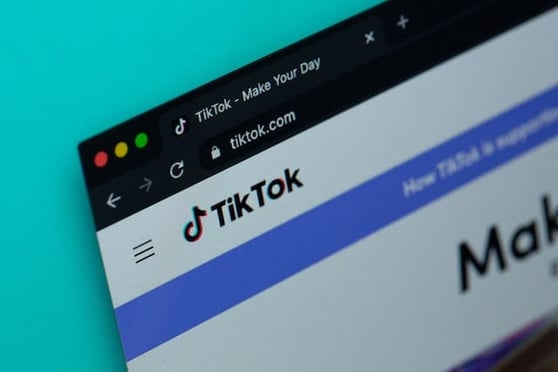Knowing how to use TikTok ads is important for organizations looking to succeed and stay ahead of the curve. This guide to TikTok ads will give you a practical overview of how to plan, launch, and manage campaigns that actually perform.
TikTok has developed into a potent instrument for advertising and a platform for amusement and self-expression. TikTok ads are incredibly useful if you want to reach a highly engaged audience and drive action through creative and entertaining video content. In this blog post, we will help you get started with TikTok advertising by looking at the different ad formats, targeting choices, campaign setup, creative approaches, performance measurement, and best practices you need to know. By the time we're done, you will have the knowledge you need to use TikTok ads to build your brand.
What Are TikTok Ads?
TikTok ads are paid video promotions that appear within the TikTok app, designed to reach users as they scroll through content. These ads can show up between videos, on the For You Page, in search results, or even as branded effects users can interact with.
Unlike traditional ads, TikTok ads are built to blend in with the platform’s short-form, fast-paced style. They rely heavily on visuals, sound, and timing. If your content looks like a typical ad, users will likely skip it. If it feels like something they’d watch anyway, it has a better chance of holding their attention and driving action.
There are different formats—some work well for brand awareness, others for direct response. What they all share is the goal of turning casual scrollers into engaged viewers and, hopefully, into customers.
Who Uses TikTok?
TikTok is used by a wide range of people, but its core audience is still largely young and highly active on mobile.

Source: https://www.shopify.com/za/blog/tiktok-statistics
Gen Z (Ages ~18–24)
This group makes up the largest share of TikTok users. They're comfortable with fast, informal content and engage heavily with trends, challenges, and creators. If your product or service appeals to younger consumers, this is your most responsive audience.
Millennials (Ages ~25–40)
Not far behind, this group uses TikTok for entertainment, product recommendations, and how-to content. They're often buyers, not just viewers, and are more likely to follow brands or shop based on content they see.
Niche Communities and Creators
TikTok’s algorithm supports subcultures—fitness, parenting, beauty, finance, B2B, and more. These communities are loyal and active, making targeted content highly effective even if it doesn’t go viral.
Brands and Businesses
From startups to global companies, more brands are using TikTok for advertising, creator partnerships, and brand storytelling—especially those wanting to reach a younger or trend-aware market.
Should All Businesses Use TikTok Ads?
No, TikTok ads aren't right for every business—but they work well for many.
Here’s how to think about it:
They make sense if:
- Your audience is under 40. If Gen Z or Millennials are part of your buyer base, TikTok is worth testing.
- Your product is visual or easy to show in action. Think fashion, food, tech, home goods, fitness, entertainment, etc.
- You’re open to informal, creative content. Polished, traditional ads won’t perform well here.
- You have a clear call to action. TikTok ads work best when there’s a simple next step—shop, sign up, download.
They may not be a fit if:
- Your audience isn’t active on TikTok. If you mainly serve older professionals or niche B2B markets, other channels might be more effective.
- Your brand isn’t ready to experiment. TikTok content needs testing, quick creative cycles, and a willingness not to overthink.
- Your offering is complex or high-ticket. These can work, but often require more education than a short-form video allows.
How Much Does TikTok Advertising Cost?
TikTok advertising costs vary, but here’s what you need to know to plan realistically:
Minimum Spend Requirements
- $50 per day at the campaign level
- $20 per day at the ad group level
These are TikTok’s required minimums—not necessarily what you’ll spend long term, but the starting point.
Auction-Based Pricing
TikTok uses an auction model, similar to Meta and Google. Your cost depends on:
- Target audience competition
- Ad relevance
- Bid strategy and budget
Cost-per-click (CPC): typically ranges from $0.50 to $1.50
Cost per 1,000 impressions (CPM): often falls between $5 $12, depending on the niche.
Factors That Affect Cost
- Audience targeting: Narrow audiences cost more
- Creative performance: Better-performing ads cost less over time
- Time of year: Costs rise during holidays or competitive seasons
- Ad format: Premium formats (like TopView) are more expensive
Why You Should Create Ads on TikTok
TikTok advertising offers what most platforms can’t: attention. People watch with sound on, they engage quickly, and they expect creativity, not polish.
Here’s why it’s worth considering:
High Engagement
Users don’t just scroll—they watch, comment, share, and take action. TikTok content often holds attention longer than static ads on other platforms.
Creative-First Format
The platform rewards bold, fast, and genuine content. If you're willing to test ideas and follow what works, you’ll stand out.
Algorithm-Driven Reach
TikTok doesn’t rely heavily on followers. Good content gets pushed to the For You Page, meaning you can reach a large audience—even with a small account.
Flexible for Budgets
You don’t need a huge ad spend to start. A/B testing, short videos, and low production costs make it easier to run small, smart campaigns.
Action-Oriented Users
TikTok drives results—sign-ups, app downloads, purchases. Users expect direct offers and respond well when the message is clear and relevant.
How Effective is TikTok Advertising?
TikTok ads are effective when the creative matches the platform. Brands that treat the content like entertainment—not traditional ads—see the best results.
What Makes Advertising on TikTok Work?
- High engagement: TikTok users spend nearly an hour per day on the app, often with sound on and full screen.
- Strong influence on purchase behavior:
- 61% of users made a purchase after seeing an ad on TikTok.
- 67% say TikTok inspired them to shop even when they weren't planning to.
- Reach without followers: The algorithm rewards good content, not follower count. One video can reach thousands if it performs well.
- Performance across the funnel: Whether you're after awareness, installs, sign-ups, or sales, TikTok offers ad formats that support each goal.
When It Doesn’t Work:
- The creative is too polished, slow, or off-brand for TikTok.
- There's no hook in the first few seconds.
- The offer or CTA isn't clear.
Types of Ads on TikTok and Their Specs
Planning a successful campaign depends on thoroughly understanding each ad format's nuances. For example, In-Feed Ads should grab users' attention immediately, considering how briefly they show in their feeds. TikTok provides a variety of advertising options, each suited to particular marketing goals:
TikTok In-Feed Video Ads
Like organic TikTok content, short, entertaining videos called "In-Feed Ads" are displayed inconspicuously in users' feeds.

The above image is AI-generated
Specs
- Video Duration: 5–60 seconds (best: 9–15 seconds)
- File Type: .mp4, .mov, .avi
- Aspect Ratio: 9:16 (vertical), 1:1 (square), or 16:9 (horizontal)
- Resolution: Minimum 540 × 960 px, recommended 1080 × 1920 px
- File Size: ≤ 500 MB
- Sound: Strongly recommended (users watch with sound on)
- Text: 12–100 characters (no emojis or special symbols)
Branded Hashtag Challenges
Businesses can create contests centered on their goods or services to entice customers to join and produce user-generated content.

The above image is AI-generated
Specs
- Includes banner image (for Discovery page): 1200 × 1200 px
- Landing page video: same specs as In-Feed
- Often bundled with music and influencer partnerships
Branded Effects
Users can add interactive filters and special effects called "branded effects" to their videos to increase brand interaction.

The above image is AI-generated
Specs
- Design files and format vary (usually provided through TikTok reps)
- Run time: Up to 10 days
- Works best alongside a hashtag challenge or campaign
TopView Ads
This premium ad placement guarantees that your advertisement is displayed as soon as users open TikTok, enhancing visibility.
Specs
- Same specs as In-Feed Ads
- Video length: up to 60 seconds
- High-impact, premium placement (priced accordingly)
Branded Scan
Using augmented reality (AR) technology, Branded Scan enables users to interact with your brand using their camera.
Specs
- Trigger Mechanism: User scans an object (QR code, product packaging, etc.) using TikTok’s camera
- Effect Format:
- 2D or 3D assets
- Built in TikTok’s Effect House (or through a partner)
- File Types:
- 3D objects: .fbx or .obj
- Textures: .png or .jpg
- Audio: .mp3 or .wav (if needed)
- Effect Duration: Typically 5–15 seconds
- Maximum File Size: 5 MB for individual assets (subject to optimization limits)
- Campaign Duration: Up to 10 days (can vary based on campaign setup)
Spark Ads
Take advantage of trending TikTok videos that align with your brand by promoting user-generated content (UGC).

The above image is AI-generated
Specs
- Uses the original post’s specs
- Must be public and authorized for promotion by the account owner
TikTok Ads vs Other Platforms
If you're considering where to invest your ad budget, it's easy to get overwhelmed. Every platform has strengths—but not every one of them will fit your product, audience, or creative approach. Here's a breakdown of how TikTok Ads compare with Facebook, Google, Instagram, and YouTube, so you can make a smart, no-nonsense decision.

H3: TikTok Ads vs Facebook Ads
Facebook has been a go-to for years, and for good reason—it offers deep targeting, massive reach, and proven results for everything from eCommerce to lead generation.
TikTok, on the other hand, thrives on speed, creativity, and audience engagement. It’s not about structured funnels—it’s about grabbing attention and riding the momentum of trends.
Choose TikTok if:
You’re targeting younger consumers and want your brand to feel current.
Choose Facebook if:
You need flexible campaign types and strong retargeting.
TikTok Ads vs Google Ads
Google Ads is intent-driven. People go there to search, and solve problems. If someone is Googling “best running shoes”, they’re likely ready to buy.
TikTok is a different game. It captures attention while users are in scroll mode—not actively searching, but open to what’s interesting.
Choose TikTok if:
You want to build awareness and reach a passive, but highly engaged, audience.
Choose Google if:
You’re focused on direct-response campaigns and bottom-of-funnel conversions.
TikTok Ads vs Instagram Ads
Instagram’s visual nature and polished aesthetic have made it a strong option for eCommerce and lifestyle brands. Its ad formats are familiar—Stories, Reels, and in-feed.
TikTok ads lean more on casual, trend-aware content. The bar is lower on polish but higher on creativity and timing.
Choose TikTok if:
You want content that feels native, fast, and relatable.
Choose Instagram if:
Your brand is visually strong, and you want to maintain a polished image.
TikTok Ads vs YouTube Ads
YouTube is the go-to for long-form video and deeper storytelling. People go there to watch with intent and stay longer.
TikTok is short-form, high-energy, and moves fast. Ads need to catch attention in the first few seconds or they’re gone.
Choose TikTok if:
You want quick wins, high reach, and trend-based creative.
Choose YouTube if:
You need to educate, explain, or guide users through a decision.
Creating a TikTok Campaign
Setting up your advertising infrastructure is the first step in developing a successful TikTok advertising campaign. Use the TikTok Ads manager to follow these steps:

Create a TikTok Business Account
- Go to TikTok for Business.
- Click “Get Started” and follow the prompts to set up your TikTok Ads Manager account.
- Fill in your business details (name, country, currency, etc.).
Install the TikTok Pixel (Optional but Recommended)
- The TikTok Pixel is a small piece of code you install on your website to track conversions like purchases, signups, or page views.
- You can find it under “Assets > Events” in your TikTok Ads Manager.
Create a Campaign
- In Ads Manager, click “Campaign” and then “Create”.
- Choose your campaign objective:
- Traffic
- Conversions
- App installs
- Lead generation
- Reach
- Video views
- Website visits
Set Your Campaign Budget
- Choose either a daily or a lifetime budget.
- You can also let TikTok optimize your ad delivery based on your goal and bid strategy.
Create an Ad Group
- Choose your placements (Automatic or Manual—Manual gives you more control).
- Define your target audience:
- Demographics (age, gender, location)
- Interests and behaviors
- Device types and OS
- Set your budget and schedule.
- Choose your optimization goal (e.g., clicks, conversions).
Create Your Ad
- Upload your creative: video or image (TikTok supports both, but videos perform better).
- Add ad text and a CTA (e.g., Shop Now, Sign Up, Learn More).
- You can also use Spark Ads to promote existing TikTok posts from your account or creators.
Launch and Monitor
- Submit your ad for review (usually takes 24 hours or less).
- Once live, track performance from your Ads Manager dashboard: monitor metrics like CTR, CPC, CPM, ROAS, and conversions.
TikTok Ad Performance Measuring
TikTok offers powerful analytics tools to assist you in understanding user behavior, engagement, and ad performance. You must monitor the following key performance indicators to evaluate the success of your TikTok advertising campaigns: click-through rate (CTR), conversion rate, cost per click (CPC), and return on ad spend (ROAS). A helpful tool is the TikTok pixel. This tiny snippet of code installed on your website or landing page tracks user actions after viewing your ad.

To optimize your TikTok ad performance, use A/B testing for optimization. By continuously testing various ad creatives, targeting options, and bidding techniques, you can continue to improve your results.
Another tip is to examine some actual instances of successful TikTok advertising efforts from companies. Learn how a competitor used hashtag challenges to increase interaction by studying what visuals, sounds, and copy they used in their videos. Then, check out how another brand used In-Feed Ads to create anticipation for a product launch, for example. Explore the usage of Branded Effects to promote user-generated content and brand interaction with a third competitor.
TikTok Ad Best Practices
For your advertising campaign to be successful, you must follow these TikTok advertising guidelines:
- Maintain your authenticity and relatability: TikTok viewers value sincerity, so make sure your brand's tone fits the platform's ethos.
- Keep up with TikTok trends: To stay relevant and successfully engage with users, keep up with current TikTok trends, viral sounds, hashtags, and issues that your target audience faces.
- Engage your audience: To promote community, reply to comments, support user-generated material, and interact with your audience.
- Follow TikTok community guidelines: Be familiar with the TikTok community guidelines to ensure your adverts follow the platform's rules.
- Scale your campaigns: After determining which techniques have been effective, scale your campaigns to reach a larger audience and accomplish your goals.
- Keep your videos short and sweet: Attention spans are short, so grab viewers quickly.
Challenges and Things to Think About
Running Ads on TikTok isn't without its challenges, despite all the goodness that can come from it. Recognizing the difficulties and factors that come with TikTok advertising is key to staying ahead. If you are new to advertising on TikTok, consider these:
- As TikTok's popularity increases, so does competition and ad saturation. To stand out in a crowded marketplace, focus on being unique and captivating.
- Maintaining transparency in your advertising strategies will help you win users' trust.
- TikTok's algorithm changes over time, impacting content discovery. Be flexible and quick to adjust to algorithm modifications.
Examples of Effective TikTok Ad Campaigns for Lead Generation
Examples of Effective TikTok Advertising
1. User-Generated Style with Clear Product Use
A skincare brand partners with a creator who films a short, casual “morning routine” using the product. It looks like normal content but includes a natural plug and clear before/after clips.
🔹 Why it works: Feels authentic. Shows the product in context. Doesn’t interrupt the feed.
2. “Hook First” Ad with Problem/Solution Format
A fitness app starts with: “If you hate the gym, watch this…”
The next 10 seconds show a quick demo of the app’s home workouts, followed by a call to download.
🔹 Why it works: Strong first line, fast pacing, clear offer. Uses TikTok’s scroll-stopping formula.
3. Creator-Led Storytelling
A travel booking site sponsors a creator to share “how I found $40 flights last weekend”. The creator shares the booking steps using the site, shows proof, and ends with a code or CTA.
🔹 Why it works: Feels like a helpful tip, not a pushy ad. Includes real results and shows the process.
4. Trend Integration
A meal delivery brand uses a trending audio clip while showing fast cuts of meals being unpacked and cooked. The visuals match the rhythm of the sound, and the brand is tagged at the end.
🔹 Why it works: Taps into the trend without overbranding. Good visuals and timing = higher watch time.
5. Branded Hashtag Challenge
A shoe brand launches #MyWeekendMoves, encouraging users to show how they wear the shoes on weekends. The brand promotes the challenge with a short branded video and creator support.
🔹 Why it works: Drives participation, builds visibility, and creates content the brand can reuse.
WSI is Here to Help You Create and Use Your TikTok Advertising Strategy
TikTok advertising has a bright future, offering countless opportunities for businesses to engage with a sizable, engaged audience. The good news is that you'll be well-equipped to use TikTok's advertising potential if you adhere to the suggestions and techniques provided here. Remember that TikTok is more than simply a platform; it's a vibrant community eagerly awaiting your company's story.
Talk to us to learn more about this guide to TikTok ads or to learn about our social media marketing services.






